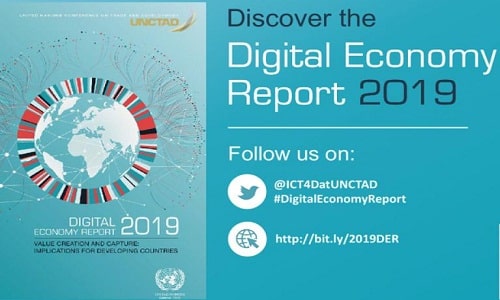United Nations Conference on Trade and Development (UNCTAD) released the first ever Digital Economy Report (DER) titled “Digital Economy Report 2019 – Value Creation and Capture: Implications for developing countries”. DER was formerly known as the Information Economy Report. It examines the scope for value creation and capture in the digital economy by developing countries.
Highlights of DER 2019
Following are the highlights of the report:
Main components of the digital economy
The 3 main components of the digital economy as stated in the DER 2019 include:
- Core aspects: Core aspects or foundational aspects of the digital economy comprises of fundamental innovations (semiconductors, processors), core technologies (computers, telecommunication devices) and enabling infrastructures (Internet and telecoms networks).
- Digital and IT sectors: It includes key products or services that rely on core digital technologies, including digital platforms, mobile applications and payment services.
- Digitalizing sectors: It includes those products where digital products and services are being increasingly used e.g. for e-commerce.
Global Internet Protocol (IP) traffic
- Global Internet Protocol (IP) traffic has grown from about 100 gigabytes (GB) per day in 1992 to more than 45,000 GB per second in 2017.
- By 2022, global IP traffic is projected to reach 150,700 GB per second.
Value in digital economy
- Estimates of the size of the digital economy range from 4.5% to 15.5% of the world’s GDP (Gross Domestic Product).
- Regarding value added in the information and communications technology (ICT) sector, the United States and China together account for almost 40% of the world’s total.
- ICT sector is the largest in Taiwan Province of China, Ireland, and Malaysia.
- The global computer services industry is dominated by the United States.
- India has the largest share among developing countries in the computer services industry. Also, India ranked fourth in terms of growth in the share of the ICT sector’s value-added in GDP between 2010 and 2017.
- In “Share of ICT services in total exports of services: Top 20 countries, 2017”, India ranked 2nd which is topped by Ireland. India is the largest developing-country exporter of such services.
- In 2018, digitally deliverable service exports amounted to $2.9 trillion, or 50% of global services exports. In the least developed countries (LDCs), such services accounted for an estimated 16% of total services exports, and they more than tripled from 2005 to 2018.
- Google has nearly 90% of the market for Internet searches. Facebook accounts for two-thirds of the global social media market and is the top social media platform in more than 90% of the world’s economies.
- The global value of e-commerce is estimated by UNCTAD to have reached $29 trillion in 2017, which is equivalent to 36% of GDP.
- The drivers of value creation in the digital economy include the digital platforms and the central role of data and digital intelligence in the digital economy.
- The three of the largest producers of telecommunication services are developing countries, namely China, India and Brazil.
Factors for the rapid rise to dominance of the digital giants
Digital giants like Google, Facebook, Amazon, WeChat etc have achieved strong market positions in certain areas. The factors for the rapid rise to dominance include
- Network effects (i.e. the more users on the platform, the more valuable it becomes for everyone).
- The platforms’ ability to extract, control and analyse data.
- Once a platform begins to gain traction and starts offering different integrated services, the costs to users of switching to an alternative service provider start to increase.
- Investment in research and development (R&D) and lobbying in domestic and international policy-making circles.
- Strategic partnership between multinational enterprises (MNEs) in traditional sectors and global digital platform corporations.
Recent trends in emerging Digital economy
Following are the recent trends in the digital economy:
- Blockchain technologies
- Three-dimensional (3D) printing (additive manufacturing)
- Internet of things (IoT)
- 5G mobile broadband
- Cloud computing
- Automation and robotics
- Artificial intelligence (AI) and data analytics
Top 10 countries (2017) in emerging E-commerce sales
| Rank | Country | Total ecommerce sales (($ billion) | As a share of GDP (%) |
| 1 | United States | 8883 | 46 |
| 2 | Japan | 2975 | 61 |
| 3 | China | 1931 | 16 |
| 4 | Germany | 1503 | 41 |
| 5 | Republic of Korea | 1290 | 84 |
| 6 | United Kingdom | 755 | 29 |
| 7 | France | 734 | 28 |
| 8 | Canada | 512 | 31 |
| 9 | India | 400 | 15 |
| 10 | Italy | 333 | 17 |
Estimated cross-border Business to Customer (B2C) sales: Top 10 merchandise exporters of 2017
| Rank | Country | Cross border B2C sales ($ billion) |
| 1 | United States | 102 |
| 2 | China | 79 |
| 3 | United Kingdom | 31 |
| 4 | Japan | 18 |
| 5 | Germany | 15 |
| 6 | France | 10 |
| 7 | Canada | 8 |
| 8 | Italy | 4 |
| 9 | Republic of Korea | 3 |
| 10 | Netherlands | 1 |
Other Highlights:
- Geographically, the development of the digital economy is highly uneven.
- The digital era requires updating of competition and taxation policies.
- New policies at national and international levels are needed to build an inclusive digital economy.
- The United States and China account for 75% of all patents related to blockchain technologies, 50% of global spending on the Internet of Things (IoT), and more than 75% of the world market for public cloud computing.
- At the current scenario, the only mandatory rule on data localisation in India is by the Reserve Bank of India (RBI) for payment systems. Other one is the Draft Personal Data Protection Bill, 2018 which consists of specific requirements on cross-border data transfers.
About UNCTAD:
♦ Established: 1964
♦ Headquarters: Geneva, Switzerland
♦ Secretary General: Dr. Mukhisa Kituyi
♦ Reports published by UNCTAD:
- Information and Economy Report/ DER
- World Economic Situation and Prospects Report
- Trade and Development Report
- World Investment Report
- The Least Developed Countries Report
- Technology and Innovation Report
- Commodities and Development Report




